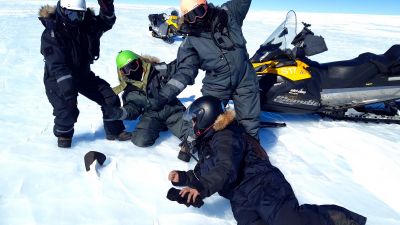
An Eventful Season for Meteorite Hunters at PEA
For more than ten years, meteorite scientists from Belgian universities have been using the Belgian Princess Elisabeth Antarctica research station as a base from which to search for meteorites, which can give clues to the origins of our solar system.
During the most recent 2022-23 austral summer research season, a team of researchers led by Vinciane Debaille from the Université Libre de Bruxelles (ULB) found several meteorites, including a very rare meteorite weighing 7.6 kg!
In this interview, Dr Debaille discusses what she and her fellow researchers from Switzerland, Japan and the US were able to accomplish during their most recent trip to Antarctica.
Is the focus of the Belgian Antarctic Meteorites and Micrometeorites (BAMM) project to look for meteorites in very specific areas?
Yes. Although our focus is on Antarctica, we’re really only interested in its blue ice fields, which is where meteorites can most easily be found as they will be concentrated by ice movement. A very famous one is located south of the Princess Elisabeth station: the Nansen Blue Ice Field. We’ve now been there three times and we’ve found more than 600 meteorites there, so it was very productive.
The only problem was to find new places. For that, we've been using a map that Veronica Tollenaar created last year. Veronica is a PhD student in glaciology at the ULB. Her work focuses on machine learning to identify possible areas where blue ice fields might concentrate meteorites. According to this map, there exist a few zones surrounding the Belgian station.
The idea of this most recent mission was to collect meteorites, but more specifically to identify new areas where there is a high probability to find them. We looked at three main areas during our most recent trip. Two of them had no meteorites, but one did. Overall, it's been a good tool to use.
Is this the first season in Antarctica for the BAMM project?
It’s a bit complicated to say, because BAMM is the name of the current research project. But under the BELARE campaigns over the years, we've had many projects that have looked for meteorites in Antarctica in collaboration between the Vrije Universiteit Brussel, the Université libre de Bruxelles and the Royal Belgian Institute of Natural Sciences. These campaigns, which have been going on for 12 years now, have included several different projects (e.g. SAMBA, BAMM, DESIRED, and now ULTIMO). That's why I prefer to refer to these expeditions as BELARE meteorite expeditions.
At the beginning of the most recent season’s campaign, you didn’t find many meteorites. When did your trips start to become successful?
We found four meteorites in the vicinity of the Niels Larsen Blue Ice Field. Then when we went back to the station, we looked in two other preselected places, and found nothing. Finally, on the last day of our campaign, we went back to the Niels Larsen Blue Ice Field by another route, and this is where we found the big 7.6 kg meteorite. It happened on the last day, at the last hour, just like in a fairytale!
Will the big meteorite stay in Belgium to be analysed?
Yes. It will be analysed at the Royal Belgian Institute of Natural Sciences. Since we brought it back frozen, we plan to unfreeze it in a vacuum so that we prevent liquid water from penetrating into the meteorite. By using a vacuum, we basically eliminate any trace of ice and snow, as the ice sublimes directly into water vapour in a vacuum.
Does the large meteorite you found come from the asteroid belt between Mars and Jupiter?
Yes. Almost all meteorites we find on Earth come from the asteroid belt, with the remaining few coming from Mars and the Moon, usually as a result of an impact on the surface of the planet or moon, which then ejects debris into space.
How old are most meteorites that you find?
They would be around 4.5 billion years - almost as old as the solar system. That's why we use them to understand the formation of the solar system.
Is there any way to determine the exact age of a meteorite?
Yes, we do so by measuring isotopes. This is what I do in my lab. We then use natural radioactivity to date to sample.
Aside from the very large meteorite, did you collect other meteorites this past season?
Yes, we collected five in total. It may not seem like a lot, but it is still much more productive than any other places in the world. The point was also to identify places where we can come back and search more.
One of the meteorites we collected is very beautiful. You can see its flowing lines. When a meteorite is plummeting towards Earth, it melts, and sometimes this melt creates flowing lines that are preserved. The big one is also very beautiful and rare as well.
What kind of logistical support did you get when you were in the field?
From PEA, we had two different kinds of logistical support. Firstly, since we went to zones that had never been explored, we needed help with the route. Alain Hubert helped us by opening the routes and finding safe places. Because of the potential of coming across crevasses, heading out to unverified areas could be very dangerous. Secondly, PEA helped us by providing camping equipment, snowmobiles, and then, of course, the station itself.
Will your team go back to Antarctica next year?
Probably not next year because it's really demanding and difficult to be away every year for that long. But who knows? Maybe in two years.
Will the BAMM project continue?
The BAMM project is now over and its successor, the DESIRED project, will continue the story. That’s why it’s easier to call it “BELARE meteorite expedition”.
Picture: Days of searching pay off when looking for meteorites - © International Polar Foundation / BAMM Proejct
